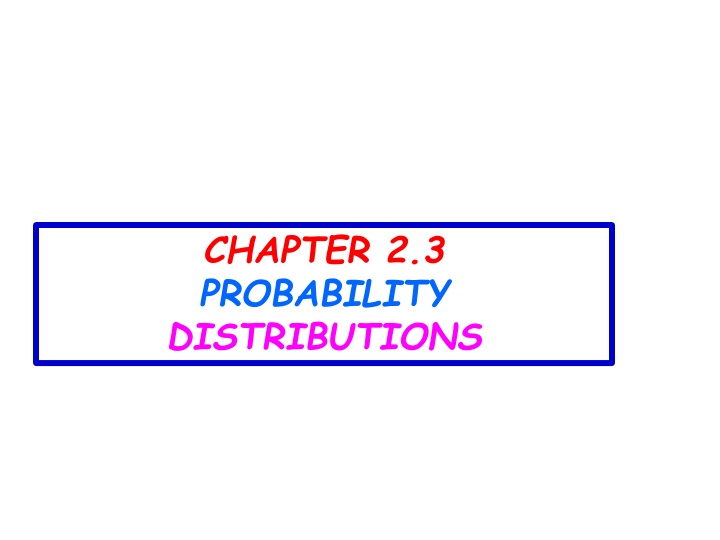
Gaussian Distribution: Characteristics and Derivations
Explore the Gaussian distribution, an approximation of the binomial and Poisson distributions, exhibiting a bell-shaped curve with characteristics like mean estimation and probability density function. Learn about the continuous nature, interval definition, and full-width at half maximum of the Gaussian distribution.
Download Presentation

Please find below an Image/Link to download the presentation.
The content on the website is provided AS IS for your information and personal use only. It may not be sold, licensed, or shared on other websites without obtaining consent from the author. If you encounter any issues during the download, it is possible that the publisher has removed the file from their server.
You are allowed to download the files provided on this website for personal or commercial use, subject to the condition that they are used lawfully. All files are the property of their respective owners.
The content on the website is provided AS IS for your information and personal use only. It may not be sold, licensed, or shared on other websites without obtaining consent from the author.
E N D
Presentation Transcript
CHAPTER 2.3 PROBABILITY DISTRIBUTIONS
2.3 GAUSSIAN OR NORMAL ERROR DISTRIBUTION The Gaussian distribution is an approximation to the binomial distribution for the special limiting case where the number of possible different observations n becomes infinitely large and the probability of success for each is finitely large so np 1. It is also, as we observed, the limiting case for the Poisson distribution as becomes large. There are several derivations of the Gaussian distribution from first principles, none of them as convincing as the fact that the distribution is reasonable, that it has a fairly simple analytic form, and that it is accepted by convention and experimentation to be the most likely distribution for most experiments. In addition, it has the satisfying characteristic that the most probable estimate of the mean from a random sample of observations x is the average of those observations x. Characteristics The Gaussian probability density is defined as This is a continuous function describing the probability of obtaining the value x in a random observation from a parent distribution with parameters and , corresponding to the mean and standard deviation, respectively. Because the distribution is continuous, we must define an interval in which the
2.3 GAUSSIAN OR NORMAL ERROR DISTRIBUTION The Gaussian distribution is an approximation to the binomial distribution for the special limiting case where the number of possible different observations n becomes infinitely large and the probability of success for each is finitely large so np It is also, the limiting case for the Poisson distribution as becomes large. In addition, it has the satisfying characteristic that the most probable estimate of the mean from a random sample of observations x is the average of those observations x. Characteristics The Gaussian probability density is defined as 1. Continuous function describing the probability of obtaining the value x in a random observation from a parent distribution with parameters and , corresponding to the mean and standard deviation, respectively. Distribution is continuous and an interval must be defined in which the value of the observation x will fall. The probability density function is properly defined such that the probability dPG(x; , ) that the value of a random observation will fall within an interval dx around x is given by dPG(x; , ) = PG(x; , )dx Considering dx to be an infinitesimal differential, and the probability density function to be normalized, so that (2.24) The width of the curve is determined by the value of , such that for x = + , the height of the curve is reduced to e -1/2 of its value at the peak:
The width of the curve is determined by the value of , such that for x = + , the height of the curve is reduced to e -1/2 of its value at the peak: The shape of the Gaussian distribution is shown in Figure 2.5. The curve displays the characteristic bell shape and symmetry about the mean We can characterize a distribution by its full-width at half maximum , often referred to as the half-width, defined as the range of x between values at which the probability PG(x; , ) is half its maximum value: With this definition, we can determine from Equation (2.23) that = 2.354 (2.28) As illustrated in Figure 2.5, tangents drawn along a portion of steepest descent of the curve intersect the curve at the e-1/2points x = and intersect the x axis at the points x = 2 .
As illustrated in Figure 2.5, tangents drawn along a portion of steepest descent of the curve intersect the curve at the e-1/2 points x = and intersect the x axis at the points x = 2 .
Standard Gaussian Distribution It is generally convenient to use a standard form of the Gaussian equation obtained by defining the dimensionless variable z = (x - )/ , because with this change of variable, we can write Thus, from a single computer routine or a table of values of PG(z), we can find the Gaussian probability function PG(x; , ) for all values of the parameters and by changing the variable and scaling the function by 1/ to preserve the normalization. Mean and Standard Deviation The parameters and in Equation (2.23) for the Gaussian probability density distribution correspond to the mean and standard deviation of the function. This equivalence can be verified by calculating and with Equations (1.13) and (1.14) as the expectation values for the Gaussian function of x and (x - )2, respectively. For a finite data sample, which is expected to follow the Gaussian probability density distribution, the mean and standard deviation can be calculated directly from Equations (1.1) and (1.9). The resulting values of x and s will be estimates of the mean and standard deviation . Values of , obtained in this way from the original 50 time measurements in Example 1.2, were used as estimates of and a in Equation
Standard Gaussian Distribution The standard form of the Gaussian equation obtained by defining the dimensionless variable z = (x - )/ , because with this change of variable, we can write Thus, from a single computer routine or a table of values of PG(z), we can find the Gaussian probability function PG(x; , ) for all values of the parameters and by changing the variable and scaling the function by 1/ to preserve the normalization. Mean and Standard Deviation The parameters and in Equation (2.23) for the Gaussian probability density distribution correspond to the mean and standard deviation of the function. This equivalence can be verified by calculating and with Equations (1.13) and (1.14) as the expectation values for the Gaussian function of x and (x - )2, respectively. For a finite data sample, which is expected to follow the Gaussian probability density distribution, the mean and standard deviation can be calculated directly from Equations (1.1) and (1.9). The resulting values of x and s will be estimates of the mean and standard deviation . Values of , obtained in this way from the original 50 time measurements in Example 1.2, were used as estimates of and a in Equation (2.23) to calculate the solid Gaussian curve in Figure 1.2. The curve was scaled to have the same area as the histogram. The curve represents our estimate of the parent distribution based on our measurements of the sample.
Integral Probability We are often interested in knowing the probability that a measurement will deviate from the mean by a specified amount x or greater. The answer can be determined by evaluating numerically the integral which gives the probability that any random value of x will deviate from the mean by less than x . Because the probability function P G(x; , a) is normalized to unity, the probability that a measurement will deviate from the mean by more than x is just 1 - PG( x; , ). Of particular interest are the probabilities associated with deviations of , 2 , and so forth from the mean, corresponding to 1,2, and so on standard deviations. We may also be interested in the probable error ( pe ), defined to be the absolute value of the deviation Ix - l such that the probability for the deviation of any random observation Ix i - I is less than 1/2. That is, half the observations of an experiment would be expected to fall within the boundaries denoted by pe If we use the standard form of the Gaussian distribution of Equation (2.29), we can calculate the integrated probability PG(z) in terms of the dimensionless variable z = (x - )l
Integral Probability We are often interested in knowing the probability that a measurement will deviate from the mean by a specified amount x or greater. The answer can be determined by evaluating numerically the integral which gives the probability that any random value of x will deviate from the mean by less than x . Because the probability function P G(x; , a) is normalized to unity, the probability that a measurement will deviate from the mean by more than x is just 1 - PG( x; , ). Of particular interest are the probabilities associated with deviations of , 2 , and so forth from the mean, corresponding to 1,2, and so on standard deviations. We may also be interested in the probable error ( pe), defined to be the absolute value of the deviation Ix - l such that the probability for the deviation of any random observation Ixi- I is less than 1/2. That is, half the observations of an experiment would be expected to fall within the boundaries denoted by pe If we use the standard form of the Gaussian distribution of Equation (2.29), we can calculate the integrated probability PG(z) in terms of the dimensionless variable z = (x - )l where z = x/ measures the deviation from the mean in units of the standard deviation . The integral of Equation (2.31) cannot be evaluated analytically, so in order to obtain the
Tables and Graphs The Gaussian probability density function PG(z) and the integral probability PG(z) are tabulated and plotted in Tables C.1 and C.2, respectively. From the integral probability Table C.2, we note that the probabilities are about 68% and 9S% that a given measurement will fall within 1 and 2 standard deviations of the mean, respectively. Similarly, by considering the 50 % probability limit we can see that the probable error is given by pe= 0.6745 . Comparison of Gaussian and Poisson Distributions A comparison of the Poisson and Gaussian curves reveals the nature of the Poisson distribution. It is the appropriate distribution for describing experiments in which the possible values of the data are strictly bounded on one side but not on the other. The Poisson curve of Figure 2.3 exhibits the typical Poisson shape. The Poisson curve of Figure 2.4 differs little from the corresponding Gaussian curve of Figure 2.5, indicating that for large values of the mean , the Gaussian distribution becomes an acceptable description of the Poisson distribution. Because, in general, the Gaussian distribution is more convenient to calculate than the Poisson distribution, it is often the preferred choice. However, one should remember that the Poisson distribution is only defined at 0 and positive integral values of the variable x, whereas the Gaussian function
Tables and Graphs The Gaussian probability density function PG(z) and the integral probability PG(z) are tabulated and plotted in Tables C.1 and C.2, respectively. From the integral probability Table C.2, we note that the probabilities are about 68% and 9S% that a given measurement will fall within 1 and 2 standard deviations of the mean, respectively. Similarly, by considering the 50 % probability limit we can see that the probable error is given by pe = 0.6745 . Comparison of Gaussian and Poisson Distributions A comparison of the Poisson and Gaussian curves reveals the nature of the Poisson distribution. It is the appropriate distribution for describing experiments in which the possible values of the data are strictly bounded on one side but not on the other. The Poisson curve of Figure 2.3 exhibits the typical Poisson shape. The Poisson curve of Figure 2.4 differs little from the corresponding Gaussian curve of Figure 2.5, indicating that for large values of the mean , the Gaussian distribution becomes an acceptable description of the Poisson distribution. Because, in general, the Gaussian distribution is more convenient to calculate than the Poisson distribution, it is often the preferred choice. However, one should remember that the Poisson distribution is only defined at 0 and positive integral values of the variable x, whereas the Gaussian function is defined at all values of x.
2.4 LORENTZIAN DISTRIBUTION There are many other distributions that appear in scientific research. Some are phenomenological distributions, created to parameterize certain data distributions. Others are well grounded in theory. One such distribution in the latter category is the Lorentzian distribution, similar but unrelated to the binomial distribution. The Lorentzian distribution is an appropriate distribution for describing data corresponding to resonant behavior, such as the variation with energy of the cross section of a nuclear or particle reaction or absorption of radiation in the Mossbauer effect. The Lorentzian probability density function PL(X; , ), also called the Cauchy distribution, is defined as This distribution is symmetric about its mean with a width characterized by its half-width . The most striking difference between it and the Gaussian distribution is that it does not diminish to 0 as rapidly; the behavior for large deviations is proportional to the inverse square of the deviation, rather than exponentially related to the square of the deviation. As with the Gaussian distribution, the Lorentzian distribution function is a continuous function, and the probability of observing a value x must be related
2.4 LORENTZIAN DISTRIBUTION There are many other distributions that appear in scientific research. Some are phenomenological distributions, created to parameterize certain data distributions. One such distribution in the latter category is the Lorentzian distribution, similar but unrelated to the binomial distribution. The Lorentzian distribution is an appropriate distribution for describing data corresponding to resonant behavior, such as the variation with energy of the cross section of a nuclear or particle reaction or absorption of radiation in the Mossbauer effect. The Lorentzian probability density function PL(X; , ), also called the Cauchy distribution, is defined as This distribution is symmetric about its mean with a width characterized by its half- width . The most striking difference between it and the Gaussian distribution is that it does not diminish to 0 as rapidly; the behavior for large deviations is proportional to the inverse square of the deviation, rather than exponentially related to the square of the deviation. As with the Gaussian distribution, the Lorentzian distribution function is a continuous function, and the probability of observing a value x must be related to the interval within which the observation may fall. The probability dPL(x; , ), for an observation to fall within an infinitesimal differential interval dx around x is given by the product of the probability density function PL(x; , ), and the size of the interval dx:
The normalization of the probability density function PL(X; , ) is such that the integral of the probability over all possible values of x is unity: where z = (x - )/( /2). Mean and Half-Width The mean of the Lorentzian distribution is given as one of the parameters in Equation (2.32). It is obvious from the symmetry of the distribution that must be equal to the mean as well as to the median and to the most probable value. The standard deviation is not defined for the Lorentzian distribution as a consequence of its slowly decreasing behavior for large deviations. If we attempt to evaluate the expectation value for the square of the deviations we find that the integral is unbounded: the integral does not converge for large deviations. Although it is possible to calculate a sample standard deviation by evaluating the average value of the square of the deviations from the sample mean, this calculation has no meaning and will not converge to a fixed value as the number of samples increases.
Mean and Half-Width The mean of the Lorentzian distribution is given as one of the parameters in Equation (2.32). It is obvious from the symmetry of the distribution that must be equal to the mean as well as to the median and to the most probable value. The standard deviation is not defined for the Lorentzian distribution as a consequence of its slowly decreasing behavior for large deviations. If we attempt to evaluate the expectation value for the square of the deviations we find that the integral is unbounded: the integral does not converge for large deviations. Although it is possible to calculate a sample standard deviation by evaluating the average value of the square of the deviations from the sample mean, this calculation has no meaning and will not converge to a fixed value as the number of samples increases. The width of the Lorentzian distribution is instead characterized by the full width at half maximum , generally called the half-width. This parameter is defined such that when x = /2, the probability density function is equal to one-half its maximum value, or P( /2; , ) = P( ; , ). Thus, the half-width 1/2is the full width of the curve measured between the levels of half maximum probability. We can verify that this identification of with the full-width at half maximum is correct by substituting x = /2 into Equation (2.32).
We can verify that this identification of f with the full-width at half maximum is correct by substituting x = /2 into Equation (2.32). The Lorentzian and Gaussian distributions are shown for comparison in Figure 2.6, for = 10 and = 2.354 (corresponding to = 1 for the Gaussian function). Both distributions are normalized to unit area according to their definitions in Equations (2.23) and (2.32). For both curves, the value of the maximum probability is inversely proportional to the half-width . This results in a peak value of 2/ = 0.270 for the Lorentzian distribution and a peak value of 1/( 2 ) = 0.399 for the Gaussian distribution. Except for the normalization, the Lorentzian distribution is equivalent to the dispersion relation that is used, for example, in describing the cross section of a nuclear reaction for a Breit-Wigner resonance:
The Lorentzian and Gaussian distributions are shown for comparison in Figure 2.6, for = 10 and = 2.354 (corresponding to = 1 for the Gaussian function). Both distributions are normalized to unit area according to their definitions in Equations (2.23) and (2.32). For both curves, the value of the maximum probability is inversely proportional to the half-width . This results in a peak value of 2/ = 0.270 for the Lorentzian distribution and a peak value of 1/( 2 ) = 0.399 for the Gaussian distribution. Except for the normalization, the Lorentzian distribution is equivalent to the dispersion relation that is used, for example, in describing the cross section of a nuclear reaction for a Breit-Wigner resonance:





















